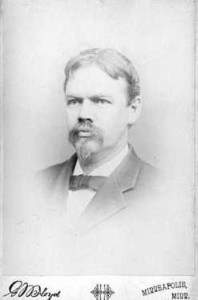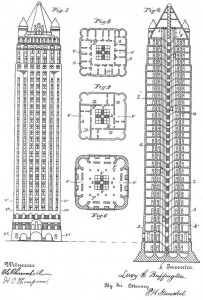Man invents structural skeleton from which tall buildings are constructed, gets patent, then ridiculed, dies in sleep, forgotten by world.
For Leroy S. Buffington, his may not have been the most fairytale-ish life of all, but, if not for his invention, Sky Scrapers may not be or have been built as we now know them – and Superman’s adventures could have been considerably fewer.
In 1888, it was all about looking up in downtown with Leroy S. Buffington – not Brown – when he applied for (in 1887) then received the US patent 383,170 on May 22, 1888 “for the steel skeleton method of construction, the basis upon which modern skyscrapers were and still are built.”
However, according to archinect.com “despite ridicule from fellow architects, (Buffington) proceeded to defend his patent by initiating a series of lawsuits aimed at collecting royalties for patent infringement. These suits dragged on through the courts, in the end winning Buffington nothing, but instead costing him $30,000 in legal fees.
In addition, the cases dragged on for so long in court, the patent rights eventually expired.
Dubbed “the father of the skyscraper” Buffington was born on September 22, 1847 in Cincinnati, Ohio.
He attended college in Cincinnati where he studied mechanical and civil engineering but his “true love” was architecture.
With many projects to his credit, including Pillsbury A Mill, the first architect designed mill, the West Hotel and many buildings for the University of Minnesota on both Minneapolis and St. Paul campuses, Buffington would become best known for his biggest and most controversial achievement first called “the Cloudscraper”
Now known as the “Sky Scraper”, Buffington developed a detailed, fully realized plan for iron- or steel-skeleton construction used in conjunction with masonry to achieve building heights never before possible. – mnopedia.org
Although Buffington’s invention became the basis upon which buildings were built, there was much ado about the skyscrapers and more than enough mockery for Buffington – despite having his ideas published in respected architectural journals.
And, no matter that he’d managed to attain national fame along with his continued work as an architect in Minneapolis with the likes of notable private clients such as Charles A. Pillsbury, Archbishop John Ireland, Knute Nelson and quite a few others, Buffington was never known as Leroy, baddest man of the (whole damn) town.
Buffington died in his sleep on February 16, 1931 and was forgotten by the world – except for the Twin Cities – and quite possibly the comic book hero best known for leaping tall buildings in a single bound.


